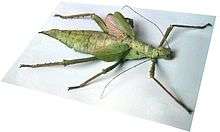Verophasmatodea
The Verophasmatodea suborder of the Phasmatodea contains the vast majority of the extant species of stick and leaf insects.
| Verophasmatodea Temporal range: Eocene - Recent | |
|---|---|
 | |
| Heteropteryx dilatata from Malaysia | |
| Scientific classification | |
| Kingdom: | Animalia |
| Phylum: | Arthropoda |
| Class: | Insecta |
| Cohort: | Polyneoptera |
| (unranked): | Anartioptera |
| Magnorder: | Polyorthoptera |
| Superorder: | Orthopterida |
| Order: | Phasmatodea |
| Suborder: | Verophasmatodea Zompro 2004 |
| Superfamilies and families | |
|
See text | |
Superfamilies and families
The two infraorders may be distinguished by the entomological meaning of the term "areola": with the presence or absence (Anareolatae) of a small ring of colour or gap in wing margin - see the Glossary of entomology terms.
Infraorder Anareolatae
- Anareolatae have a Worldwide distribution (except Antarctic)
- Diapheromeridae - Kirby, 1904
- Lonchodidae - Brunner von Wattenwyl, 1893[1][2]
- Phasmatidae - Gray, 1835
Infraorder Areolatae
- Superfamily Aschiphasmatoidea - Brunner von Wattenwyl, 1893
- †Archipseudophasmatidae[3]
- Aschiphasmatidae - Brunner von Wattenwyl, 1893 (Tropical Southeast Asia)
- Damasippoididae - Zompro, 2004 (Madagascar)
- Prisopodidae - Brunner von Wattenwyl, 1893 (Central and South America, south Africa, India, Indo-China, Malesia)
- Superfamily Bacilloidea - Brunner von Wattenwyl, 1893
- Anisacanthidae - Günther, 1953 (Madagascar)
- Bacillidae - Brunner von Wattenwyl, 1893 (Africa, Europe)
- Heteropterygidae - Kirby, 1896 (Australasia, east and southeast Asia)
- Superfamily Phyllioidea - Brunner von Wattenwyl, 1893
- Phylliidae - Brunner von Wattenwyl, 1893 (Australasia, Asia, Pacific)
- Superfamily Pseudophasmatoidea - Rehn, 1904 (especially Americas, Madagascar, Asia, Australasia, Europe)
- Heteronemiidae - Rehn, 1904
- Pseudophasmatidae - Rehn, 1904
gollark: Ah, I see.
gollark: Let me check the ArchLinuxARM page.
gollark: There are a few, but unfortunately software support is worse.
gollark: There are cheaper or more powerful SBCs.
gollark: I said performance per dollar.
References
- Robertson, James A.; Bradler, Sven; Whiting, Michael F. (2018). "Evolution of Oviposition Techniques in Stick and Leaf Insects (Phasmatodea)". Frontiers in Ecology and Evolution. 6. doi:10.3389/fevo.2018.00216.
- Brock, Paul D.; Otte, Daniel (2018). "Phasmida species file online, Version 5.0". Retrieved 2019-03-22.
- Zompro, O. 2001. The Phasmatodea and Raptophasma n. gen., Orthoptera incertae sedis, in Baltic amber (Insecta: Orthoptera). Mitteilungen des Geologisch-Paläontologischen Institutes der Universität Hamburg 85: 229–261.
External Links

- Phasmid Study Group: Verophasmatodea
This article is issued from Wikipedia. The text is licensed under Creative Commons - Attribution - Sharealike. Additional terms may apply for the media files.